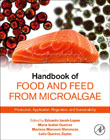
Handbook of Food and Feed from Microalgae: Production, Application, Regulation, and Sustainability
Jacob-Lopes, Eduardo
Queiroz, Maria Isabel
Manzoni Maroneze, Mariana
Zepka, Leila Queiroz
Handbook of Food and Feed from Microalgae: Production, Application, Regulation, and Sustainability is a comprehensive resource on all aspects of using microalgae in food and feed. This book covers applied processes, including compounds found in microalgae applicable in food and feed, food products developed with microalgae biomass in the composition, the use of microalgae in animal nutrition, and challenges and recent advances. Written by global leading experts on microalgae, the book's sections discuss the fundamentals of food and feed from microalgae, including its biodiversity, biogeography, genomics, nutritional purposes and compounds found within microalgae like proteins, vitamins and antioxidants. In addition, the book explains the incorporation of microalgae into meat, dairy, beverages and wheat products, as well as in real-world food applications in aquaculture, mollusk, poultry and pet feeding. The last two sections cover challenges and issues such as bioavailability and bio-accessibility and how to address safety, regulatory, market, economics and environment concerns. Examines current data behind food and feed production using microalgae-based processes Analyzes and details the use of microalgae across industries and disciplines Addresses and offers solutions to safety, market, environmental and economic issues INDICE: Part I - Fundamentals 1. Food and feed from microalgae: A historical perspective 2. Biodiversity and biogeography of microalgae with food potential 3. Genome editing approaches applied to microalgae for food purposes 4. Mass production of microalgae for nutritional proposals 5. Metabolomic reprogramming tool to improve microalgae cell composition 6. Commercial facilities of microalgae food and feed products around the world 7. Downstream processing of microalgae for food ingredients in industrial application Part II - Microalgae Compounds with Food and Feed Applications 8. Proteins, peptides, and amino acids from microalgae 9. Lipids and fatty acids from microalgae 10. Intracellular and exocellular carbohydrates in microalgae 11. Minerals in microalgae biomass 12. Vitamins from microalgae 13. Food enzymes from microalgae 14. Microalgal Carotenoids 15. Microalgal chlorophylls 16. Microalgal phycobiliproteins 17. Microalgae sterols 18. Volatile and semi-volatile organic compounds as food ingredients 19. DHA- and EPA-rich oil from microalgae 20. ß-carotene from Dunaliella: Production, applications and advances 21. Astaxanthin from Haematococcus: Production, applications and advances 22. Phycocyanin from Arthrospira: Production, applications and advances 23. Antioxidant compounds from microalgae biomas 24. Microalgae-based products and their immunomodulatory activities Part III - Applications of Microalgae and Microalgal Compounds in Food Products 25. Techno-functional properties of microalgae in food products 26. Microalgae as a key ingredient in meat analogues 27. Application of microalgae in baked goods and pasta 28. Microalgae added to beverages, dairy, prebiotic and probiotic products 29. Microalgae as dietary supplements in tablet, capsule, and powder 30. Encapsulation of microalgae-based products for food and feed applications Part IV - Applications of Microalgae and Microalgal Compounds in Animal Nutrition 31. Microalgae application in feeds for ruminants 32. Microalgae application in aquaculture feed 33. Microalgae application in poultry feed 34. The role of microalgae in eggs production: Composition, bioactive compounds, and sensory quality 35. Microalgae application in bivalve mollusks feed 36. Microalgae in pet food 37. Microalgae as feed additives on livestock performance Part V - Recent Advances and Challenges 38. The next generation of commercial microalgae-based foods 39. Technological bottlenecks of the use of microalgae in food and feed 40. Bioavailability and bio-accessibility of bioactive compounds from microalgae 41. Disruptive technologies to improve the performance of microalgae cultures 42. Sensorial characters of microalgae biomass and its individual components 43. Non-fuel microalgae biorefineries Part VI - Safety, Regulatory, Market, Economic, and Environmental Considerations 44. Microalgae in food and feed: Safety and toxicological aspects 45. Quality control of microalgae-based products 46. Analytical protocols applied to analysis of microalgal biomass 47. Microalgae in food and feed: Legal concerns 48. Global market opportunities of food and feed products from microalgae 49. Sustainability metrics in the microalgae-based ingredients production 50. Techno-economic assessment of microalgae as food ingredient and final products 51. Strategy and design of innovation policy road mapping for microalgae-based foods 52. Social acceptance of microalgae-based foods 53. Foodomics approach to investigate the health benefits of microalgae in the diet Concluding Remarks
- ISBN: 978-0-323-99196-4
- Editorial: Academic Press
- Encuadernacion: Rústica
- Páginas: 550
- Fecha Publicación: 01/02/2023
- Nº Volúmenes: 1
- Idioma: Inglés
